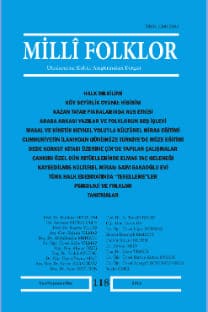Divanu lugati't-Türk'te yer alan atasözlerindeki metaforlar
Bu çalışmada, Türk dilinin en eski sözlüğü olan Dîvânu Lugâti’t-Türk’te (DLT) yer alan atasözlerindeki metaforların açıklanması yoluyla Türk kavram dünyası ve düşünce yapısıyla ilgili ipuçları elde edilmesi amaçlanmıştır. Geleneksel olarak metafor, farklı iki şey arasında karşılaştırma içeren, genellikle iki şey arasındaki benzerliği anımsatmak için bir şey söyleyerek diğer şeyi kastetmek için bir kelime veya deyimin kullanıldığı bir konuşma biçimi olarak görülür. Metaforlar kültürden kültüre farklılıklar gösteren, ifadeye canlılık ve hareket kazandıran unsurlardır. Onlar bizim fiziksel, toplumsal ve kültürel deneyimimiz yoluyla ortaya çıkar. DLT’deki metaforların bir çoğu varlık bilgisiyle ilgilidir. Bu metaforlar pek çok mesaj taşır. Bu mesajlarda, genellikle, bir emir veya öğüt kipliği emir cümlelerinde değil, bildirme cümlelerinde yerleşmiştir. Bu durum, emir veya öğüdün geri çevrilmesine karşı etkili bir önlem olarak görülebilir.
Metaphors in proverbs of dîvânu Lugâti’t-Turk
In this paper, it is aimed to get clues about the concept world and idea construction of Turks through the explanation of metaphors in the proverbs of Dîvânu Lugâti’t-Turk (DLT) that is the oldest dictionary of Turkish language. Traditionally, metaphor is viewed as a figure of speech in which a word or a phrase that ordinarily means one thing is applied to another thing in order to suggest a likeness between the two, implying the comparison between the two different things. Metaphors are elements that get vigor and deed to expression and display variety to another culture from a culture. They appear through our physical, social and cultural experience. A lot of metaphors in DLT are ontological. These metaphors are loaded with lots of message. In these messages, usually, an order or an advice modality is not located in imperative sentences but is located in declarative sentences. This situation is be able to seen as an effective precaution toward refuse order or advice.
___
- Atalay, Besim. Divanü Lûgat-it-Türk Tercümesi (I-IV). Ankara: TDKY, 1998.
- Başgöz, İlhan. “Atasözleri Hakkında Atasözleri ya da Atasözlerinin Toplumsal Anlamı”. (çeviren: Nurdan Tuhfe Toçoğlu). Milli Folklor, sayı 70, (Yaz 2006):85-91.
- Clauson, Sir Gerard. An Etymological Dictionary of Pre-Thirteenth-Century Turkish. Oxford: The Clarendon Press, 1972.
- Dankoff, Robert ve J.KELLY. Mahmud al- Kaşgari Compendium of The Turkic Dialects (Divan Lugat-at Turk), I-III, Sources of Oriental Languages and Literatures 7. Turkish Sources VII. Cambridge: Harvard University Press, 1982-1985.
- Erdem, Melek. Türkmen Türkçesinde Metaforlar. Ankara: KÖKSAV, Tengrim Türklük Bilgisi Araştırmaları Dizisi: 6. 2003.
- Feyearts, Kurt. “Referring the inheritance hypothesis: interaction between metaphoric and metonymic hierarchies”. Barcelona, A. (ed.), Metaphor and Metonymy at the Crossroads. A Cognitive Perspective, Berlin/ New York: Mouton de Gruyter, 2000, 59-78.
- Janda, Laura A. “Peircean semiotics and cognitive linguistics: a case study of the Russian genitive”. Shapiro, M. (ed.) The Peirce Seminar Papers. New York/Oxford: Berghahn Books, 1999, 441-466.
- Kövecses, Zoltán ve Günter Radden. “Towards a theory of metonymy”. Panther, K. and Radden, G. (eds.) Metonymy in Language and Thought. Amsterdam/ Philadelphia: John Benjamins, 1999. 17-60.
- Lakoff, George ve Mark Johnson. Metaphors We Live By. Chicago: University of Chicago Press, 1980..
- Lakoff, George ve Mark Johnson. “The contemporary theory of metaphor”. Ortony, A. (ed.) Metaphor and Thought. Cambridge: Cambridge University Press, 1993. 1-16.
- Lakoff, George ve Mark Johnson. 2005, Metaforlar Hayat, Anlam ve Dil. (çev. Gökhan Yavuz Demir). İstanbul: Paradigma Yayınları.
- Mendoza, Ibáñez Francisco J. “Metaphor, metonymy and conceptual interaction”. Atlantis Vol.19, 1: 1997, 281-295.
- Radden, Günther. “How metonymic are metaphors?”. Barcelona, A. (ed.) Metaphor and Metonymy at the Crossroads, Berlin/ New York: Mouton de Gruyter, 2000. 93-108.
- Yaylagül, Özen. “Divanü Lûgati’t-Türk’teki Ad Aktarmalı (Metonymic) Yapılar”. Modern Türklük Araştırmaları Dergisi (2006), 3/1: 77-88.
- Yunusoğlu, Mağfiret Kemal. “Dîvânu Lugâti’t- Türk’te Metafor ve Metonimi”. Barutcu-Özönder, F.S. (ed.) Kâşgarlı Mahmûd Kitabı. Ankara: Kültür ve Turizm Bakanlığı Yayınları, 2008. 341-352.
- ISSN: 1300-3984
- Yayın Aralığı: Yılda 4 Sayı
- Başlangıç: 1989
- Yayıncı: Geleneksel Yayıncılık Eğitim San. Tic. Ltd. Şti.
Sayıdaki Diğer Makaleler
İlhan Başgöz'ün halk edebiyatı araştırmalarına katkısı
Divanu lugati't-Türk'te yer alan atasözlerindeki metaforlar
10 yıl sonra Dede Korkut Oğuznameleri ve notlar
Millî Folklor Dergisi'nin bibliyometrik profili (2007-2009)
Hatay'da müslüman hıristiyan etkileşimi: St. Georges ya da hızır kültü
Zeliha'nın rüyaları ve gerçeklik
Türkiye'de MİT ve masal çalışmaları veya bir olumsuzlama ve tek-tipleştirme öyküsü
